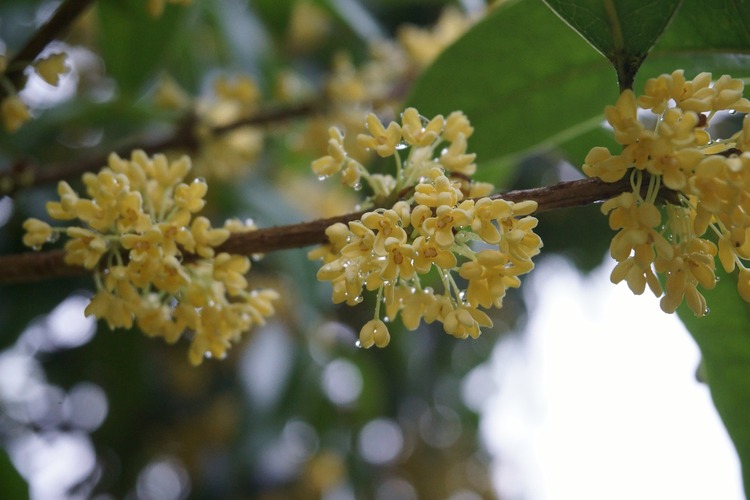Osmanthus green tea is a blend that combines the fragrant osmanthus flower with high-quality green tea leaves, resulting in a delicate and refreshing flavor.
This blend has a long history in Chinese culture, where it is often served during special occasions and celebrations. The osmanthus flower’s floral aroma perfectly complements the green tea’s grassy notes, creating a balanced and enjoyable drinking experience.
Keep reading to find out more about this inviting blend.
Please note: This article contains affiliate links, meaning I may earn a commission if you make a purchase by clicking a link. Of course, this comes at no extra cost to you and helps me keep offering readers solid information.

What is Osmanthus Green Tea?
Osmanthus green tea is a type of green tea that is infused with the sweet fragrance of osmanthus flowers. This tea is a popular beverage in China and other parts of Asia.
Osmanthus is a flowering plant that is native to China. It has a sweet, fruity aroma that is often described as apricot-like. The flowers are often used in teas, desserts, and perfumes.
Green tea is a type of tea that is made from the leaves of the Camellia sinensis plant. Beverages coming from the Camellia sinensis plant are considered true teas (beverages coming from other plants are called infusion or herbal teas).
Green tea is not oxidized. When tea leaves are plucked from the plant, a series of chemical reactions start to darken the leaves. In green tea, this reaction (called oxidation) is stopped by applying heat to the leaves (steaming or pan-firing). This helps to preserve the natural antioxidants and nutrients in the leaves.
Osmanthus green tea is made by blending green tea leaves with osmanthus flowers. In some cases, green tea is scented with osmanthus (petals are removed after the scent is fixed). This is a reasonably well-known blend. You should be able to find it in the market. If not, you can prepare your blend (we will show you how to do this below).
Osmanthus Green Tea Flavor Profile
Osmanthus green tea boasts a captivating flavor profile. Here’s a breakdown of that profile:
- Floral: The most prominent characteristic of osmanthus green tea is its floral aroma and flavor. The osmanthus flowers infuse the tea with a sweet, fragrant floral note reminiscent of ripe peaches or apricots.
- Sweetness: Osmanthus flowers contribute a natural sweetness to the tea, which can be reminiscent of honey or nectar. This sweetness balances the slight bitterness often found in green tea and adds a pleasant, mellow aspect to the overall taste.
- Green Tea Base: The base of green tea provides a vegetal and sometimes slightly grassy undertone to the blend. This serves as a foundation for the osmanthus flowers’ floral notes and prevents the tea from becoming overly sweet.
- Nutty Undertones: Some osmanthus green teas may have nutty undertones, which can add complexity to the flavor profile. These notes are often subtle and can range from chestnut to almond-like.
- Subtle Citrus: Depending on the specific green tea used and the brewing parameters, subtle citrus undertones might complement the overall flavor profile. These citrus notes can enhance the tea’s refreshing quality.
- Smooth Finish: Osmanthus green tea tends to have a smooth and gentle finish that lingers pleasantly on the palate. Combining floral, sweet, and vegetal elements contributes to this well-rounded aftertaste.
- Aromatic: The aroma of osmanthus green tea is captivating and uplifting. It carries the delightful scent of fresh osmanthus flowers and green tea leaves’ characteristic aroma.

Brewing Guide
To make a delicious cup of tea, you will need the following ingredients:
- Osmanthus green tea (1 teaspoon or as desired)
- If you are creating your own blend, use your favorite green tea leaves (1 teaspoon or as desired) and dried osmanthus flowers (1 teaspoon or to taste)
- Fresh, filtered water (about 8 ounces)
- Optional: sweetener of your choice (honey, sugar, etc.)
You will also need some equipment:
- A teapot or infuser
- A cup or glass
- Teaspoon
- Timer
After gathering the ingredients and equipment, you can follow the following steps:
- Start by boiling fresh water and let it cool down for a few minutes. The ideal temperature for brewing green tea is around 80°C (176°F).
- Place the blend (or green tea leaves and flowers) into a tea infuser or teapot.
- Pour the hot water over the tea leaves and let it steep for 2-3 minutes. Avoid over-steeping, as it can make the tea taste bitter.
- Once the tea is steeped, remove the infuser or strain the tea leaves from the teapot.
- Enjoy your delicious cup of osmanthus green tea! You can drink it hot. Or, let it cool down and serve it over ice.
Infusion: Green tea can be infused multiple times. For subsequent infusions, increase the steeping time by 30 seconds for each additional brew.
Steeping time: The ideal steeping time for osmanthus green tea is 2-3 minutes. You can adjust the steeping time based on your personal preference. If you prefer a more robust flavor, steep the tea for a longer period.
Remember, brewing tea is an art, and the perfect cup of tea depends on your taste. Experiment with different steeping times and water temperatures until you find the perfect balance of flavor and aroma that suits your palate.
Health Benefits
Drinking osmanthus green tea can provide you with numerous health benefits. This tea is packed with antioxidants, polyphenols, and other vital nutrients that can help improve your overall health and well-being.
One of the most significant benefits of osmanthus green tea is its potential to help you manage weight. This tea can act as an appetite suppressant, which can help you eat less and reduce your calorie intake. Additionally, it has a mild sedative effect that can help calm your nerves and reduce stress, leading to overeating.
The tea can also protect your insulin-producing cells, which can help prevent diabetes and other chronic diseases. The polyphenol compounds in this tea can help reduce inflammation in your body, which can help protect your liver, endocrine system, and kidneys.
Drinking this type of green tea can also help detox your body by eliminating toxins and reducing oxidative stress. This can help improve your immune system and reduce your risk of developing intestinal diseases, stomach aches, and bloating.
Furthermore, osmanthus green tea can help improve your eyesight and skin tone. This tea contains cobalt, selenium, manganese, molybdenum, and other essential nutrients that can help keep your skin and eyes healthy.

Caffeine Content
On average, a cup of osmanthus green tea contains around 20-30 milligrams of caffeine, which is less than a cup of coffee but more than some other types of tea, such as herbal teas. However, it’s important to note that the caffeine content can vary depending on factors such as brewing time, water temperature, and the specific type of tea leaves used.
If you’re looking for a caffeine-free option, you may want to try an herbal or decaffeinated version of the tea. While these teas won’t provide the same caffeine boost, they can still offer a delicious and soothing beverage option.
Osmanthus in Different Teas
Osmanthus is a popular flower used in various teas due to its unique aroma and taste. Here are some of the different types of teas that use osmanthus.
Black Tea with Osmanthus
Black tea with osmanthus is a popular blend that combines the bold taste of black tea with the sweet, floral notes of osmanthus. This tea is perfect for those who enjoy a strong cup of tea with a touch of sweetness.
Osmanthus Oolong Tea
Osmanthus oolong tea is a type of tea that is made by blending oolong tea leaves with osmanthus flowers. This tea has a smooth, slightly sweet taste with a floral aroma that is perfect for those who enjoy a light and refreshing cup of tea.
Herbal Tea with Osmanthus
Herbal tea with osmanthus is a caffeine-free alternative to traditional teas. This tea combines various ingredients (lavender, chamomile, mint, lemongrass, rose petals, jasmine) with osmanthus flowers to create a soothing and aromatic blend. It is perfect for those who want to enjoy the benefits of osmanthus tea without the caffeine.
Pure Osmanthus Tea
Pure osmanthus tea is made by steeping osmanthus flowers in hot water. This tea has a delicate, sweet taste with a floral aroma that is perfect for those who want to enjoy the pure essence of osmanthus.
Osmanthus Beyond Tea
Aside from being an excellent ingredient for tea, Osmanthus fragrans, commonly known as sweet olive, is a flowering plant with many uses. The plant belongs to the Oleaceae family and is native to Asia. However, it is also grown in the United States, particularly in the southeastern region.
Here are some common uses for osmanthus flowers:
Culinary Delights: In Chinese cuisine, osmanthus flowers are used to infuse desserts, pastries, and beverages. They can be added to rice dishes, jams, jellies, and even soups, enhancing the flavor and providing a pleasant fragrance.
Aromatics and Potpourri: The aromatic nature of osmanthus flowers makes them popular for creating potpourri and scented sachets. Dried osmanthus flowers can be added to mixtures to release a sweet and soothing fragrance.
Perfumery: The delicate floral scent of osmanthus flowers is often used in perfumery. The flowers’ aroma can be captured through various extraction methods and incorporated into perfumes and fragrances.
Cosmetics and Skincare: Osmanthus flowers’ natural fragrance is sometimes used in cosmetics and skincare products. The aroma can add a luxurious touch to lotions, creams, and scented oils.
Flavoring Agents: Osmanthus flowers can be used as a natural flavoring agent in sweet and savory dishes. Their floral notes can enhance the overall taste of dishes without overwhelming other flavors.
Alcoholic Beverages: Some alcoholic beverages, such as wines and liqueurs, incorporate osmanthus flowers to infuse their distinctive aroma and taste.
Decoration: The vibrant yellow-orange color of osmanthus flowers can add visual appeal to dishes, cakes, and desserts, making them a popular choice for decorative purposes.
Buying Recommendations
If you are interested in buying this blend online (or ingredients to prepare your blend), please take into consideration these recommendations:
Cha Wu-Osmanthus & LongJing Green Tea Bags

ELITEA 4oz Dried Osmanthus Flower Herb Loose Leaf Tea

TooGet Fragrant Osmanthus Fragrans Herb Loose Leaf Tea

Frequently Asked Questions
What are the health benefits of Osmanthus Tea?
Osmanthus Tea is known for its numerous health benefits. It contains antioxidants that help reduce the risk of chronic diseases. It also helps improve digestion, boost the immune system, and reduce inflammation. Osmanthus Tea is also known to promote healthy skin and hair.
What is the recipe for making Osmanthus Green Tea?
You must brew green tea leaves and add dried osmanthus flowers to make this. The recommended ratio is one teaspoon of osmanthus flowers for every two cups of water. Steep the tea for about three minutes, strain the tea, and enjoy.
Is Osmanthus Green Tea good for weight loss?
This tea can help with weight loss, a healthy diet, and exercise. It contains catechins that help boost metabolism and burn fat. However, it is essential to note that drinking osmanthus green tea alone will not lead to significant weight loss.
Does Osmanthus Green Tea contain caffeine?
Yes, this tea contains caffeine. However, the caffeine content is lower than that of black tea or coffee.
What is the taste of Osmanthus Tea?
Osmanthus tea has a sweet and floral taste with a slightly fruity aroma. It is a light and refreshing tea that can be enjoyed hot or cold.

I hope you have enjoyed the article! See you next time!
Have you tried this tea?
More About Floral Teas
What Does Jasmine Tea Taste Like?
What Does Chrysanthemum Tea Taste Like?